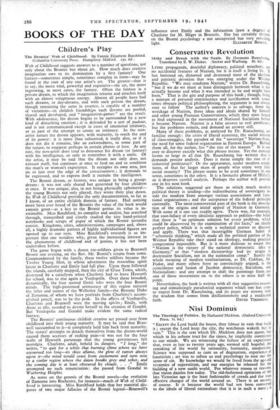BOOKS OF THE DAY
Children's Play
The lirontes' Web of Childhood. By Fannie Elizabeth Ratchford. (Columbia University Press. Humphrey Milford. 23s. 6d )
Web of Childhood suggests answers to a number of questions, not only about the Brontes but about art. How much does creative imagination owe to its domination by a first fantasy? One fantasy—sometimes simple, sometimes complex in form—may be found at the root of any one artist's art. The greater—that is to say, the more vital, powerful and expansive—the art, the more ingrowing, in most cases, the fantasy. Often the fantasy is a private dream, to which the imagination returns and attaches itself • with an almost voluptuous energy. Almost all people have had such dreams, or day-dreams, and with each person the dream, though remaining the same in essence, is capable of a number of variations—in childish friendships such dreams are pooled, shared and developed, and " imagination-games " are the result. With adolescence, the dream begins to be surrounded by a new kind of disturbing emotion ; it is defended by a sort of pudeur, and is not communicated except in cases of emotional intimacy, or as part of the attempt to create an intimacy. In the non- artist nature the dream appears, with maturity, to reach the end of its power: it is more than exhausted, it really dies, or if it does not die it remains, like an awkwardness, in some part of the nature, to reappear perhaps in certain phases of love. At any rate, the non-artist does tend to denounce his dream (or fantasy) with his intelligence, or only to remember it with a smile. Of the artist, it may be said that the dream not only does not exhaust itself, but continues at once to feed on and to condition the man's or woman's experience. It occupies its own area, just on or just over the edge of the consciousness; it demands to be expressed, and to express itself it recruits the intelligence.
The Brontë dream, or fantasy, was unique in being a group- dream : it was not only shared but generated by four children at once. It was unique, also, in not being physically ephemeral— the young Brontës not only played, they wrote their play down. So Web of Childhood provides the only documentation, so far as I know, of an entire childish domain of fantasy. Had nothing more been ever heard of the Brontes the value of the book would remain great—as a key to the Bronte genius its value is in- estimable. Miss Ratchford, its compiler and analyst, has searched through, transcribed and closely studied the tiny hand-printed notebooks and scraps of paper of which the Bronte juvenilia consist. Kingdoms, cities, administrations, campaigns and, above all, a highly dramatic pattern of highly individualised figures are opened up to our eyes. Miss Ratchford's research is so im- portant that one wonders why, given the increasing interest in the phenomena of childhood and of genius, it has not been undertaken before.
The game began with a dozen toy-soldiers given to Branwell Bronte one evening, on the Rev. Mr. Brontes rettrrn from town. Commandeered by the family, these twelve soldiers became the Twelve Young Men, in whose adventures the masculine spirit latent in Charlotte and Emily had full play. Upon them followed the islands, carefully mapped, then the city of Glass which, destroyed by a cataclysm when Charlotte had to leave Haworth for school, was to rise again as Verdopolis. Over these brooded, dynamically, the four named Genii who were the four Brontë minds. The high-passioned aristocracy of this region enjoyed the titles and names of the Wellesley family—the Byronic Duke of Zamorna, of whom we have portraits from Charlotte's accom- plished pencil, was to be the peak. In the affairs of Verdopolis, Charlotte and Branwell were the moving spirits ; Emily, with Anne as ally, seceded to devote herself to the creation of Gondal. But Verdopolis and Gondal make evident the same radical fantasy.
The Brontes' continuous childish creative act passed over from childhood into their young maturity. It may be said that Bran- well succumbed to it—it completely held him back from maturity. The sisters' attempts to detach themselves from the dream-world caused them accesses of racking pain—it was not for the four walls of Haworth parsonage that the young governesses felt nostalgia. Charlotte, adult, beheld its dangers. "I long," she writes, "to quit for a while that burning clime where we have sojourned too long—its skies aflame, the glow of sunset always upon it—the mind would cease from excitement and turn now to a cooler region where the dawn breaks grey and sober, and the coming day is at least obscured by clouds. . . ." Emily attempted no such renunciatiOn: she passed from Gondal to Wuthering Heights.
As notes on the genesis of the Brontë novels—the evolution of Zamorna into Rochester, for instance—much of Web of Child- hood is interesting. Miss Ratchford holds that her material dis- poses of two major fallacies of the Brontë legend—Branwell's
influence over Emily and the infatuation (past a degree) of Charlotte for M. Heger in Brussels. She has certainly thrown on the Brontë psychology a not unexpected but very revealing


























 Previous page
Previous page